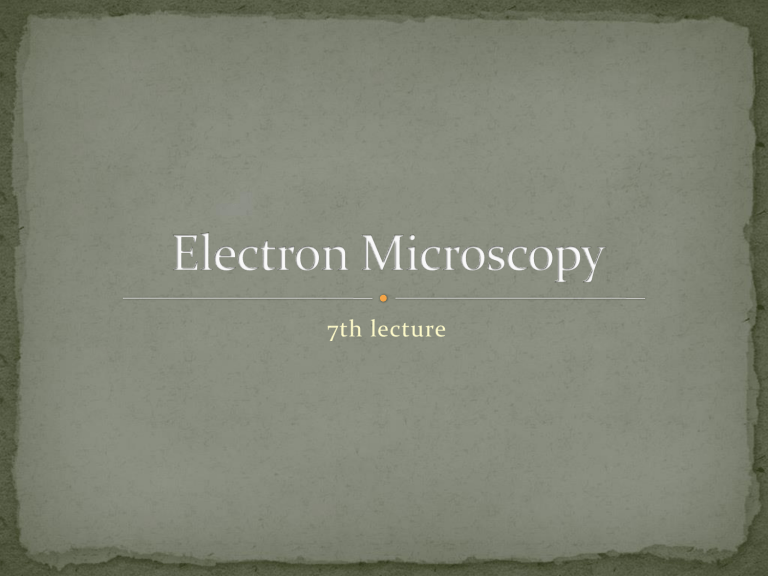Electron Microscopy 6th lecture

7th lecture
4 Basic staining mechanisms
1.
2.
3.
4.
1-Elective solubility
2-Metallic impregnation
3-Histochemical reactions
4-Staining with dyes
Classification of dyes
Common staining methods
1-Elective solubility:
This is the mechanism by which stains that are dissolved in a solvent are more soluble in the tissue component than they are in the solvent. This mechanism is primarily used in the demonstration of fat in frozen sections. The dyes used are usually of the Sudan type (Sudan III, Sudan IV).
2-Metallic impregnation:
The deposition of metallic silver onto tissue elements may be used to demonstrate a wide variety of structures and substances. Metallic impregnation is used widely in the demonstration of reticular fibres, basement membranes, fungi, cellular inclusions and nerve cells and their processes.
3-Histochemical reactions:
These are methods in which there is a clear understanding of the mechanisms involved in the reaction. Perls ’ reaction for ferric iron deposits (Figure.8), the interaction between potassium ferrocyanide (a constituent of Perls ’ solution) and the ferric iron in the tissues produces the pigment Prussian blue at the site of ferric iron.
(Figure .8): Perls
’ reaction for ferric iron. The deposits of ferric iron are stained blue.
4-Staining with dyes:
The majority of staining procedures in routine diagnostic pathology will fall into this group. In many cases the understanding behind the mechanism of staining is not clearly defined and the results will often depend upon the skill and knowledge of the histotechnologist.
Dyes may be classified as natural or synthetic. Natural dyes include haematoxylin, whilst synthetic dyes will include the greater majority of dyes used in histotechnique (e.g. eosin, methylene blue and basic fuchsin). Dyes may also be classified as acidic, basic or neutral.
Acidic and basic dyes:
Simplistically, acidic dyes (anionic) are attracted to tissue elements with basic properties such as the cytoplasm of cells. Basic dyes (cationic) will be attracted to structures of an acidic nature such as the DNA in the cell nucleus. By using a combination of acid and basic dyes of a contrasting colour, the nucleus and cytoplasm can be differentiated.
This forms the basis of the stain haematoxylin and eosin (H&E), a method used in most diagnostic histopathology laboratories to demonstrate general structure.
Neutral dyes:
Neutral dyes are produced by the combination of solutions of acid and basic dyes. The resulting product stains both acidic and basic structures from a single solution. Romanowsky stains used, for example, in demonstrating cells in bone marrow, are a combination of methylene blue and eosin.
Metachromasia:
Dyes that combine with certain tissue elements producing a colour that is different from the original dye are termed ‘metachromatic’. Metachromatic staining methods may be used for the demonstration of connective tissue mucins, mast cell granules, amyloid and cartlilage.
Fluorescence:
The majority of staining methods are visualized using visible light. Dyes that have the ability to absorb ultraviolet light and then transmit that light into the visible spectrum are termed ‘fluorescent’.
Fluorescent dyes may be used to demonstrate
Mycobacterium tuberculosis.
Fluorescent microscopes are required to view the preparations and a darkened room is necessary for optimum clarity. Fluorescent staining is often short-lived and photography is used to provide a permanent record.
Direct dyes:
Dyes that have the ability to combine with tissue structures from simple aqueous or alcoholic solutions are termed ‘direct’ dyes.
Indirect dyes:
Dyes that have no direct affinity for the tissue structures and require the use of an intermediary substance to allow staining are termed
‘indirect’ dyes. The intermediary substance is referred to as a
‘mordant’ (similar to a catalyst). The dye combines with the mordant, which combines with the tissue element, producing a dye – mordant– tissue complex.
Common staining methods:
Routine staining methods may be grouped into nine categories
General structure:
The haematoxylin and eosin method (commonly referred to as H&E) is one of the most widely used of the general structure stains used in diagnostic histopathology
(Figure.9). Careful control of this process allows the various structures (muscle, collagen and red blood cells) to be selectively demonstrated in different intensities of pink to red.
Haematoxylin and eosin-stained section of kidney showing a centrally placed glomerulus. Nuclei are stained blue (the differing intensities dependent upon the amount of nuclear chromatin present) and the general structure pink. Red blood cells are salmon pink.
Simple staining solutions:
A 0.5
–1% aqueous solution of methylene blue (for example) will stain all tissue structures blue.
Selective removal of the dye using washing and alcohols will demonstrate tissue elements in differing intensities of blue.
Romanowsky stain:
This is neutral dye (see above) which when applied to paraffin wax sections can produce a similar staining reaction to that of H&E.
Connective tissue fibers and muscle:
Collagen and muscle: van Gieson : van Gieson and its variants are the most commonly used stains for collagen and muscle. The staining solution is a mixture of picric acid and acid fuchsin.
Trichromes: will demonstrate collagen and muscle differentially (Figure.10). Muscle staining is red, whilst collagen may be blue or green
Demonstration of connective tissues is using a trichrome method. Muscle fibres are stained red, collagen blue, nuclei black and red blood cells bright red
Reticular fibers:
Silver impregnation:
Reticuslar fibres are primarily demonstrated using silver impregnation methods (Figure.11)
Silver impregnation of reticular fibres in a section of liver. A fine black network of fibres outlines the cells. The coarser staining (bottom right) is collagen.
Carbohydrates and mucosubstances:
Periodic acid--Schiff reaction (PAS):
The PAS reaction is used throughout pathology to demonstrate a wide range of substances:
Glycogen:
The PAS reaction is frequently used for the demonstration of glycogen.
Mucosubstances:
Mucosubstances are commonly found as mixtures of various types and include mucins. Mucins are found in many tissue sites (e.g. glandular tissue and connective tissue). Neutral mucins may be stained by the PAS reaction (Fig. 12), whilst acid mucins may be demonstrated with alcian blue.
Demonstration of mucin staining using a combination of the periodic acid–
Schiff (PAS) method and Alcian blue. Neutral mucins are stained magenta, acid mucins blue and mixtures deep purple blue
Microorganisms:
Microorganisms that can be demonstrated histologically include bacteria, viral inclusions, fungi and spirochaetes. Simple stains such as methylene blue will often provide a quick and easy means of identifying the presence of organisms within a section. However, methylene blue will provide information regarding only their morphology.
Bacteria:
Bacteria are divided into Gram-positive or Gram negative. Following staining with the crystal violet stain, where iodine is used as a mordant or ‘trapping agent’, precipitating the dye within the cytoplasm of Gram-positive bacteria, a red counterstain is used to demonstrate Gram negative bacteria. The technique requires skill, as it is possible to over-differentiate the crystal violet, rendering Grampositive bacteria red.
Acid alcohol-fast bacilli:
These organisms are commonly demonstrated using the Ziehl –
Neelsen (ZN) method. A fluorescent dye (auramine-rhodamine) may also be used. Viewed under a fluorescent microscope the organism fluoresces yellow/green.
Viral inclusions:
There are no specific staining methods for viral inclusions, as many of the methods will stain other structures.
Phloxine tartrazine has been used to demonstrate viral inclusion bodies and orcein is regularly used for the demonstration of hepatitis B. The demonstration of viral inclusions has largely been replaced by immunocytochemical methods.
Fungi:
Fungi may be quite apparent in H&E-stained sections but can be more selectively stained by PAS, Gram ’s stain, Ziehl –Neelsen and sGiemsa.
Spirochaetes:
Spirochaetes are probably the most difficult organisms to demonstrate in tissue sections. The classical method of Levaditi was performed on tissue blocks that were impregnated with silver. Helicobacter.
Neurological tissues:
In routine diagnostic histopathology, the demonstration of neurological elements by conventional staining methods is largely confined to those of nerve cells.

